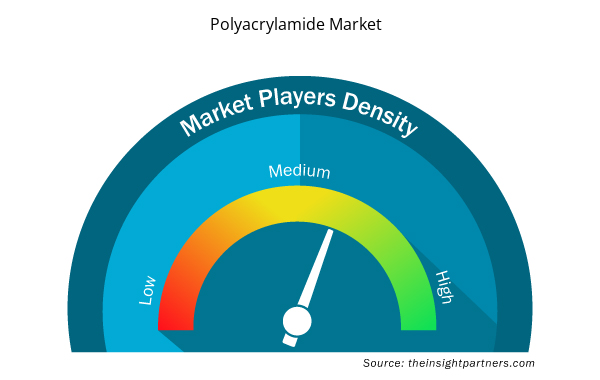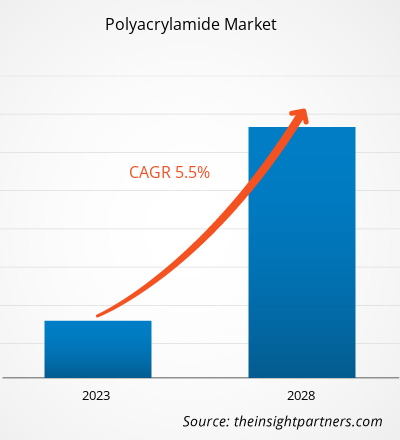[調査レポート] ポリアクリルアミド市場は2022年に47億1,479万米ドルと評価され、2028年には64億8,530万米ドルに達すると予測されており、 2022年から2028年にかけて5.5%のCAGRを記録すると予想されています。
世界中で急速に成長している水処理産業が、ポリアクリルアミド市場の成長を牽引すると予測されています。ポリアクリルアミドは、合成の長鎖ホモポリマーです。分子量が高く、水への溶解度が高いため、水処理産業に適しています。増粘剤、結合剤、凝集剤として広く使用されています。需要の増加によるエネルギープロジェクトへの投資により、石油用途でのポリアクリルアミドの需要も増加しています。たとえば、米国は、需要の増加に対応し、石油、石油、石油化学誘導体に関する中東諸国への依存を減らすために、シェールオイルとガスの探査プロジェクトに投資しています。
市場は SNFグループ、BASF SE、Kemiraなどの多国籍企業によって支配されており、総市場シェアの50%以上を占めています。これらの多国籍企業は、国内外の市場に直接的または間接的に製品を流通させるシステムを持っています。さらに、企業は世界的な需要の高まりに対応するために生産を増やすことが期待されており、最終用途産業向けのさまざまな製品の製造におけるポリアクリルアミドの需要も見込まれています。SNFやBASF SEなどの主要メーカーはブランド価値と戦略的パートナーシップを持っているため、市場でのポリアクリルアミド製品のマーケティングが容易です。メーカーは、製品の品質を向上させ、研究開発への投資を増やしてポリアクリルアミドのコストを削減し、消費者ベースを活用することに重点を置いています。
要件に合わせてレポートをカスタマイズする
このレポートの一部、国レベルの分析、Excelデータパックなど、あらゆるレポートを無料でカスタマイズできます。また、スタートアップや大学向けのお得なオファーや割引もご利用いただけます。
- このレポートの主要な市場動向を入手してください。この無料サンプルには、市場動向から見積もりや予測に至るまでのデータ分析が含まれます。
2021年、アジア太平洋地域はポリアクリルアミド市場で最大のシェアを占めました。アジア太平洋地域は、工業化と人口の増加により、工業用途の水浄化の需要が増加したため、ポリアクリルアミドの最大の市場です。この地域の強力な製薬および化学産業部門は大量の廃水を生み出しており、予測期間中に水処理化学物質としてのポリアクリルアミドの需要を促進すると予想されます。この地域は世界有数のパルプおよび紙市場の1つでもあり 、山東パルプアンドペーパー株式会社を含むいくつかの主要なパルプおよび紙産業の本拠地です。中国、インド、その他のアジア太平洋地域の石油およびガス産業からのポリアクリルアミドの需要が、この地域の市場需要を牽引すると予想されます。大規模な石炭採掘と洗浄事業により、中国はポリアクリルアミドの最大の市場の1つになりました。インドは、この地域の水処理と石油およびガス事業の成長により、廃水処理事業向けのポリアクリルアミドの最も急成長している市場の1つになると予想されています 。
COVID-19パンデミックがポリアクリルアミド市場に与える影響
COVID-19パンデミックは、廃水処理、パルプおよび製紙製造などのさまざまな最終用途産業向けのポリアクリルアミドの製造に使用される原材料のサプライチェーンの混乱により、2020年に世界市場に深刻な影響を及ぼしました。さらに、いくつかの国でのロックダウン措置の緩和と多くの業界での業務活動の再開により、2021年からポリアクリルアミド市場は回復しました。さらに、COVID-19ワクチン接種プログラムの急速なペースは、過去数四半期にわたるポリアクリルアミド市場の成長を支えました。
市場分析
鉱業と繊維産業の発展がポリアクリルアミド市場に有利に働く
繊維業界では、ポリアクリルアミドは繊維の後処理の仕上げ剤として使用されています。繊維に柔らかい保護層を作ることができます。この化学繊維の範囲は、強力な吸湿性により糸切れ率を下げることができます。ポリアクリルアミドは、材料に耐火性と耐静電気性を与えます。繊維化学薬品として、優れた接着性と高い弾力性を提供します。また、シリコンフリーのポリマー安定剤としても機能します。
鉱業では、ポリアクリルアミドは水または水溶液から鉱物固形物を凝集分離するために使用されます。鉱業では石炭洗浄に大量の水を使用するため、廃水処理にも使用されます。
アプリケーションインサイト
ポリアクリルアミド市場は、種類によってカチオン系、アニオン系、非イオン系に分類されます。カチオン系が最大の市場シェアを占めています。カチオン系ポリアクリルアミドは、その低用量要件と高い効率性から、スラッジ調整剤として使用されています。英国などの多くの欧州諸国で石炭洗浄活動が増加するにつれて、ポリアクリルアミドポリマーの需要が増加すると予想されており、さまざまなグレードの石炭の準備と分離、および石炭微粉の回収と処理のための幅広いモバイルおよびモジュール式石炭洗浄ユニットの開発は、英国のポリアクリルアミド市場の成長の重要な原動力です。
ポリアクリルアミド市場における主要な市場プレーヤーには、SNF、Kemria Oyj、BASF SE、中国石油天然気集団、安徽联成精細化学、三井化学株式会社、Ashalnd Inc.、Black Rose Industries Ltd.、Xitao Polymer Co., Ltd.、および Dongying Kechuang Biochemical Industrial Co. Ltd. などがあります。これらの企業は、さまざまな最終用途産業向けに幅広いポリアクリルアミド製品ポートフォリオを提供しています。また、発展途上国にも拠点を置いています。これらの市場プレーヤーは、顧客の要件を満たす高品質で革新的な製品の開発に重点を置いています。
ポリアクリルアミド市場の地域別分析
予測期間を通じてポリアクリルアミド市場に影響を与える地域的な傾向と要因は、Insight Partners のアナリストによって徹底的に説明されています。このセクションでは、北米、ヨーロッパ、アジア太平洋、中東、アフリカ、南米、中米にわたるポリアクリルアミド市場のセグメントと地理についても説明します。

- ポリアクリルアミド市場の地域別データを入手
ポリアクリルアミド市場レポートの範囲
| レポート属性 | 詳細 |
|---|---|
| 2022年の市場規模 | 47億1000万米ドル |
| 2028年までの市場規模 | 64億9000万米ドル |
| 世界のCAGR(2022年 - 2028年) | 5.5 % |
| 履歴データ | 2020-2021 |
| 予測期間 | 2023-2028 |
| 対象セグメント | タイプ別
|
| 対象地域と国 | 北米
|
| 市場リーダーと主要企業プロフィール |
|
市場プレーヤーの密度:ビジネスダイナミクスへの影響を理解する
ポリアクリルアミド市場は、消費者の嗜好の変化、技術の進歩、製品の利点に対する認識の高まりなどの要因により、エンドユーザーの需要が高まり、急速に成長しています。需要が高まるにつれて、企業は提供を拡大し、消費者のニーズを満たすために革新し、新たなトレンドを活用し、市場の成長をさらに促進しています。
市場プレーヤー密度とは、特定の市場または業界内で活動している企業または会社の分布を指します。これは、特定の市場スペースに、その規模または総市場価値と比較して、どれだけの競合相手 (市場プレーヤー) が存在するかを示します。
ポリアクリルアミド市場で事業を展開している主要企業は次のとおりです。
- SNF
- ケミラ
- BASF SE
- ブラックローズインダストリーズ株式会社
- 西涛ポリマー株式会社
免責事項:上記の企業は、特定の順序でランク付けされていません。

- ポリアクリルアミド市場のトップキープレーヤーの概要を入手
レポートの注目点
- ポリアクリルアミド市場における進歩的な業界動向は、プレーヤーが効果的な長期戦略を策定するのに役立ちます。
- 先進国市場と発展途上国市場で採用されているビジネス成長戦略
- 2020年から2028年までのポリアクリルアミド市場の定量分析
- ポリアクリルアミドの世界市場における需要の推定。
- ポリアクリルアミド市場におけるバイヤーとサプライヤーの有効性を示すポーターの5つの力の分析
- 競争市場の状況を理解するための最近の動向
- ポリアクリルアミド市場の成長を牽引・抑制する要因と市場動向および見通し
- 商業的利益を支える市場戦略を強調することで意思決定プロセスを支援する
- さまざまなノードにおけるポリアクリルアミド市場の規模
- 市場の詳細な概要とセグメンテーション、およびポリアクリルアミド業界の動向
- 有望な成長機会のあるポリアクリルアミド市場の規模
- 過去2年間の分析、基準年、CAGRによる予測(7年間)
- PEST分析とSWOT分析
- 市場規模価値/数量 - 世界、地域、国
- 業界と競争環境
- Excel データセット



Report Coverage
Revenue forecast, Company Analysis, Industry landscape, Growth factors, and Trends

Segment Covered
This text is related
to segments covered.

Regional Scope
North America, Europe, Asia Pacific, Middle East & Africa, South & Central America

Country Scope
This text is related
to country scope.
よくある質問
Asia Pacific is estimated to register the fastest CAGR in the global polyacrylamide market over the forecast period. Wastewater and water treatment industry would increase the demand for polyacrylamide during the forecast period, with projection in the need for water purification. Stricter regulatory measures on wastewater treatment are expected to increase water treatment activities in the region along with growing environmental concerns in the region, which in turn is positively impacting industry growth. In addition, the development of polyacrylamide polymers to produce polyacrylamide gels and powders is expected to open new applications for the life sciences and pharmaceutical industries in the region.
The pulp and paper manufacturing segment held the second largest share of the market in 2022. Its function is to improve the quality of paper, improve the pulp dehydration performance, improve the retention of fine fibers and fillers, and reduce the consumption of raw materials and environmental pollution. The monomers are reduced from the cross-linked state to a simpler form, making the absorbent material.
The liquid segment held the largest market share. The liquid polyacrylamide has wide range of applications. This process applies to water treatment, and processes like paper making and screen printing. Polyacrylamide can be supplied in a powder or liquid form, with the liquid form being subcategorized as solution and emulsion polymer.
The anionic segment held the largest market share. The main cause of this increase is the properties of the anion, which is due to the high molecular weight and high degree of polymerization. In addition, it exhibits flexibility such as shear property, cohesion, dispersibility, thickening property and strength reduction. It is also economically viable, which makes it particularly popular in its field.
The major players operating in the global polyacrylamide market are SNF, Kemria Oyj, BASF SE, China National Petroleum Corporation, Anhui Jucheng Fine Chemicals, Mitsui Chemicals, Inc., Ashalnd Inc., Black Rose Industries Ltd., Xitao Polymer Co., Ltd., Dongying Kechuang Biochemical Industrial Co. Ltd.
In 2022, Asia Pacific held the largest share of the global polyacrylamide market. Asia Pacific is the largest market for polyacrylamide due to increasing industrialization with increasing population in the region, which has increased the demand for water purification for industrial applications. The region's strong pharmaceutical and chemical industry sector has generated large amounts of wastewater, which is expected to drive the demand for polyacrylamide as a water treatment chemical during the forecast period.
Trends and growth analysis reports related to Chemicals and Materials : READ MORE..
The List of Companies - Polyacrylamide Market
- SNF
- Kemira
- BASF SE
- Black Rose Industries Ltd.
- Xitao Polymer Co., Ltd.
- Dongying Kechuang Biochemical Industrial Co.Ltd.
- Ashland
- Mitsui Chemicals, Inc.
- Anhui Jucheng Fine Chemicals
- China National Petroleum Corporation
The Insight Partners performs research in 4 major stages: Data Collection & Secondary Research, Primary Research, Data Analysis and Data Triangulation & Final Review.
- Data Collection and Secondary Research:
As a market research and consulting firm operating from a decade, we have published and advised several client across the globe. First step for any study will start with an assessment of currently available data and insights from existing reports. Further, historical and current market information is collected from Investor Presentations, Annual Reports, SEC Filings, etc., and other information related to company’s performance and market positioning are gathered from Paid Databases (Factiva, Hoovers, and Reuters) and various other publications available in public domain.
Several associations trade associates, technical forums, institutes, societies and organization are accessed to gain technical as well as market related insights through their publications such as research papers, blogs and press releases related to the studies are referred to get cues about the market. Further, white papers, journals, magazines, and other news articles published in last 3 years are scrutinized and analyzed to understand the current market trends.
- Primary Research:
The primarily interview analysis comprise of data obtained from industry participants interview and answers to survey questions gathered by in-house primary team.
For primary research, interviews are conducted with industry experts/CEOs/Marketing Managers/VPs/Subject Matter Experts from both demand and supply side to get a 360-degree view of the market. The primary team conducts several interviews based on the complexity of the markets to understand the various market trends and dynamics which makes research more credible and precise.
A typical research interview fulfils the following functions:
- Provides first-hand information on the market size, market trends, growth trends, competitive landscape, and outlook
- Validates and strengthens in-house secondary research findings
- Develops the analysis team’s expertise and market understanding
Primary research involves email interactions and telephone interviews for each market, category, segment, and sub-segment across geographies. The participants who typically take part in such a process include, but are not limited to:
- Industry participants: VPs, business development managers, market intelligence managers and national sales managers
- Outside experts: Valuation experts, research analysts and key opinion leaders specializing in the electronics and semiconductor industry.
Below is the breakup of our primary respondents by company, designation, and region:

Once we receive the confirmation from primary research sources or primary respondents, we finalize the base year market estimation and forecast the data as per the macroeconomic and microeconomic factors assessed during data collection.
- Data Analysis:
Once data is validated through both secondary as well as primary respondents, we finalize the market estimations by hypothesis formulation and factor analysis at regional and country level.
- Macro-Economic Factor Analysis:
We analyse macroeconomic indicators such the gross domestic product (GDP), increase in the demand for goods and services across industries, technological advancement, regional economic growth, governmental policies, the influence of COVID-19, PEST analysis, and other aspects. This analysis aids in setting benchmarks for various nations/regions and approximating market splits. Additionally, the general trend of the aforementioned components aid in determining the market's development possibilities.
- Country Level Data:
Various factors that are especially aligned to the country are taken into account to determine the market size for a certain area and country, including the presence of vendors, such as headquarters and offices, the country's GDP, demand patterns, and industry growth. To comprehend the market dynamics for the nation, a number of growth variables, inhibitors, application areas, and current market trends are researched. The aforementioned elements aid in determining the country's overall market's growth potential.
- Company Profile:
The “Table of Contents” is formulated by listing and analyzing more than 25 - 30 companies operating in the market ecosystem across geographies. However, we profile only 10 companies as a standard practice in our syndicate reports. These 10 companies comprise leading, emerging, and regional players. Nonetheless, our analysis is not restricted to the 10 listed companies, we also analyze other companies present in the market to develop a holistic view and understand the prevailing trends. The “Company Profiles” section in the report covers key facts, business description, products & services, financial information, SWOT analysis, and key developments. The financial information presented is extracted from the annual reports and official documents of the publicly listed companies. Upon collecting the information for the sections of respective companies, we verify them via various primary sources and then compile the data in respective company profiles. The company level information helps us in deriving the base number as well as in forecasting the market size.
- Developing Base Number:
Aggregation of sales statistics (2020-2022) and macro-economic factor, and other secondary and primary research insights are utilized to arrive at base number and related market shares for 2022. The data gaps are identified in this step and relevant market data is analyzed, collected from paid primary interviews or databases. On finalizing the base year market size, forecasts are developed on the basis of macro-economic, industry and market growth factors and company level analysis.
- Data Triangulation and Final Review:
The market findings and base year market size calculations are validated from supply as well as demand side. Demand side validations are based on macro-economic factor analysis and benchmarks for respective regions and countries. In case of supply side validations, revenues of major companies are estimated (in case not available) based on industry benchmark, approximate number of employees, product portfolio, and primary interviews revenues are gathered. Further revenue from target product/service segment is assessed to avoid overshooting of market statistics. In case of heavy deviations between supply and demand side values, all thes steps are repeated to achieve synchronization.
We follow an iterative model, wherein we share our research findings with Subject Matter Experts (SME’s) and Key Opinion Leaders (KOLs) until consensus view of the market is not formulated – this model negates any drastic deviation in the opinions of experts. Only validated and universally acceptable research findings are quoted in our reports.
We have important check points that we use to validate our research findings – which we call – data triangulation, where we validate the information, we generate from secondary sources with primary interviews and then we re-validate with our internal data bases and Subject matter experts. This comprehensive model enables us to deliver high quality, reliable data in shortest possible time.


 このレポートの無料サンプルを入手する
このレポートの無料サンプルを入手する